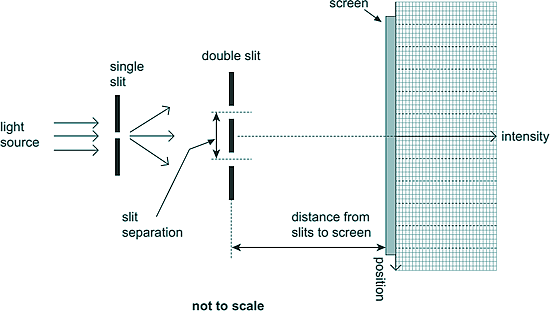Young Slits
Q1. The diagram shows Young's double-slit experiment performed with a tungsten filament lamp as the light source.

(a) On the graph paper section within the above diagram, sketch a graph to show how the intensity varies with position for a monochromatic light source.
[2 marks]
(b)
(i) For an interference pattern to be observed the light has to be emitted by two coherent sources. Explain what is meant by coherent sources.
[1 mark]
(ii) Explain how the use of the single slit in the arrangement in the diagram makes the light from the two slits sufficiently coherent for fringes to be observed.
[1 mark]
(iii) In this experiment light behaves as a wave. Explain how the bright fringes are formed.
[3 marks]
(c)
(i) A scientist carries out the Young double-slit experiment using a laser that emits violet light of wavelength 405 nm.
The separation of the slits is 5.00 × 10–5 m.
Using a metre ruler the scientist measures the separation of two adjacent bright fringes in the central region of the pattern to be 4 mm.
Calculate the distance between the double slits and the screen.
[2 marks]
(ii) Describe the change to the pattern seen on the screen when the violet laser is replaced by a green laser.
Assume the brightness of the central maximum is the same for both lasers.
[1 mark]
(iii) The scientist uses the same apparatus to measure the wavelength of visible electromagnetic radiation emitted by another laser.
Describe how he should change the way the apparatus is arranged and used in order to obtain an accurate value for the wavelength.
[3 marks]
(Total 13 marks)







